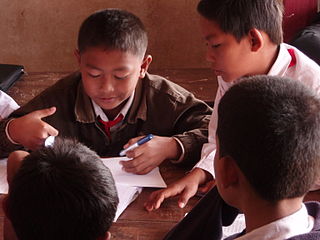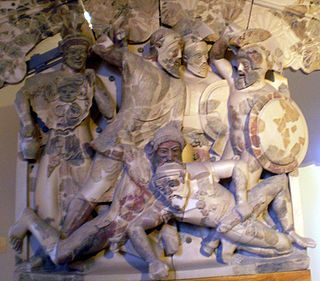
Dinosaurs are a diverse group of reptiles of the clade Dinosauria. They first appeared during the Triassic period, between 243 and 233.23 million years ago (mya), although the exact origin and timing of the evolution of dinosaurs is a subject of active research. They became the dominant terrestrial vertebrates after the Triassic–Jurassic extinction event 201.3 mya and their dominance continued throughout the Jurassic and Cretaceous periods. The fossil record shows that birds are feathered dinosaurs, having evolved from earlier theropods during the Late Jurassic epoch, and are the only dinosaur lineage known to have survived the Cretaceous–Paleogene extinction event approximately 66 mya. Dinosaurs can therefore be divided into avian dinosaurs—birds—and the extinct non-avian dinosaurs, which are all dinosaurs other than birds.

The Jurassic is a geologic period and stratigraphic system that spanned from the end of the Triassic Period 201.4 million years ago (Mya) to the beginning of the Cretaceous Period, approximately 145 Mya. The Jurassic constitutes the middle period of the Mesozoic Era and is named after the Jura Mountains, where limestone strata from the period were first identified.

The narwhal, is a species of toothed whale. It is a member of the family Monodontidae, and the only species in the genus Monodon. An adult narwhal is typically 3.0 to 5.5 m in length and 800 to 1,600 kg in weight. The most prominent feature of the species is an adult male's long single tusk that can be up to 3 m (9.8 ft). The narwhal is white in color and has irregular blackish-brown markings scattered across the body. Instead of a dorsal fin, it possesses a shallow dorsal ridge. It is a social animal, and may associate in groups of up to 20 members. Carl Linnaeus scientifically described the species in 1758 in his work Systema Naturae.

Attention deficit hyperactivity disorder (ADHD) is a neurodevelopmental disorder characterised by executive dysfunction occasioning symptoms of inattention, hyperactivity, impulsivity and emotional dysregulation that are excessive and pervasive, impairing in multiple contexts, and otherwise age-inappropriate.

Panarthropoda is a proposed animal clade containing the extant phyla Arthropoda, Tardigrada and Onychophora. Panarthropods also include extinct marine legged worms known as lobopodians ("Lobopodia"), a paraphyletic group where the last common ancestor and basal members (stem-group) of each extant panarthropod phylum are thought to have risen. However the term "Lobopodia" is sometimes expanded to include tardigrades and onychophorans as well.

The Theban Cycle is a collection of four lost epics of ancient Greek literature which tells the mythological history of the Boeotian city of Thebes. They were composed in dactylic hexameter verse and believed to be recorded between 750 and 500 BC. The epics took place before the Trojan War and centered around the Theban royal family.

The atmosphere of Mars is the layer of gases surrounding Mars. It is primarily composed of carbon dioxide (95%), molecular nitrogen (2.85%), and argon (2%). It also contains trace levels of water vapor, oxygen, carbon monoxide, hydrogen, and noble gases. The atmosphere of Mars is much thinner than Earth's. The average surface pressure is only about 610 pascals (0.088 psi) which is less than 1% of the Earth's value.

Martin Litchfield West, was a British philologist and classical scholar. In recognition of his contribution to scholarship, he was awarded the Order of Merit in 2014.

Alhagi is a genus of Old World plants in the family Fabaceae. They are commonly called camelthorns or manna trees. There are four accepted species, which range from northern Africa and Greece through western and central Asia to India and northern China.

Alhagi maurorum is a species of legume commonly known, variously, as camelthorn, Caspian manna, and Persian mannaplant. This shrub is native to the region extending from the Mediterranean to Russia, but has been introduced to many other areas of the world, including Australia, southern Africa, and the western United States. The perennial plant grows from a massive rhizome system which may extend over six feet into the ground. New shoots can appear over 20 feet from the parent plant. Above the ground, the plant rarely reaches four feet in height. It is a heavily branched, gray-green thicket with long spines along the branches. It bears small, bright pink to maroon pea flowers and small legume pods, which are brown or reddish and constricted between the seeds. The seeds are mottled brown beans.

Mesorhizobium is a genus of Gram-negative soil bacteria. At least one, the nitrogen fixing species, Mesorhizobium loti, forms symbiotic root nodules with plants in the genus Lotus. Strain MAFF303099 of M. japonicum has been fully sequenced.

Autism, formally called autism spectrum disorder (ASD) or autism spectrum condition (ASC), is a neurodevelopmental disorder marked by deficits in reciprocal social communication and the presence of restricted and repetitive patterns of behavior. Other common signs include difficulties with social interaction, verbal and nonverbal communication, along with perseverative interests, stereotypic body movements, rigid routines, and hyper- or hyporeactivity to sensory input. Autism is clinically regarded as a spectrum disorder, meaning that it can manifest very differently in each person. For example, some are nonspeaking, while others have proficient spoken language. Because of this, there is wide variation in the support needs of people across the autism spectrum.

Nephrozoa is a proposed major clade of bilaterian animals. It includes all bilaterians other than Xenacoelomorpha. It contrasts with the Xenambulacraria hypothesis, which instead posits that Xenocoelomorpha is nested within Bilateria as most closely related to Ambulacraria. Which hypothesis is correct is controversial. Authors supporting the Xenambulacraria hypothesis have suggested that the genetic evidence used to support Nephrozoa may be due to systematic error.
Coleophora amasiella is a moth of the family Coleophoridae that can be found in Iran, Iraq, Jordan, Palestine, Syria, and Turkey.
Mesorhizobium alhagi is a gram-negative, aerobic non-spore-forming, motile bacteria from the genus of Mesorhizobium which was isolated from wild Alhagi sparsifolia in north-western China.
Mesorhizobium camelthorni is a gram-negative aerobic, non-spore-forming, motile bacteria from the genus of Mesorhizobium which was isolated from Alhagi sparsifolia in Alaer in the Xinjiang Province in China.
Alhagi Marie Touray Sisay, known as Touray, is a Spanish professional footballer who plays as a striker.
Chitinophaga alhagiae is a Gram-negative and rod-shaped bacterium from the genus of Chitinophaga which has been isolated from rhizospheric soil from the plant Alhagi sparsifolia from Xinjiang in China.
Malcolm Davies is a British classicist and textual critic of Ancient Greek literature, and is Emeritus Research Fellow in Classics at St John's College, Oxford. He specialises in the Greek epic cycle, Greek lyric poetry and Greek tragedy, and has edited texts from various ancient Greek poets.












